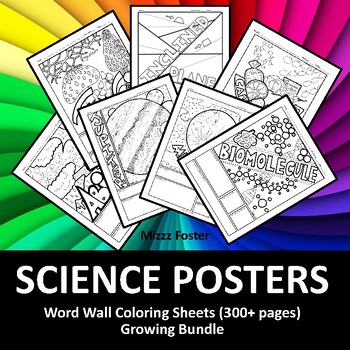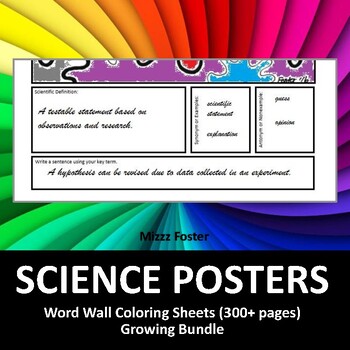Science Posters 380+ Word Wall Coloring Sheets: Biology, Chemistry, Physics
- Zip
What educators are saying
Description
Are you looking for a fun and interactive way to boost scientific vocabulary in your classroom? Look no further than an interactive science word wall! With its colorful and visually appealing design, an interactive science word wall is a powerful tool that engages students and helps them expand their scientific knowledge. By displaying important vocabulary words prominently in your classroom, students will be able to see and interact with them every day, reinforcing their understanding and retention.
This collection includes ALL 300+ Science terms I have illustrated so far. Each word wall poster has a word wall art graphic that students can color. There is a designated box to write the scientific definitions, synonyms or examples, antonyms or non-examples, and space to write a sentence using the word.
This is a growing bundle. I will consistently be adding more worksheet terms and the price will rise as more and more terms are added, but you will be able to continually download the file with every update.
This set includes words from Life Sciences such as Biology, Human Anatomy, and Environmental Science. There is a collection of Physical Science words with topics in Chemistry, Physics, Astronomy, and Earth Science. I also included the FREE General Science folder with experimental design words.
Explore a world of scientific discovery with my hand-drawn engaging Educational Science Coloring Pages. These meticulously designed sheets are more than just coloring fun; they introduce scientific terminology in a captivating manner, making them perfect for both STEM (Science, Technology, Engineering, and Mathematics) and STEAM (Science, Technology, Engineering, Arts, and Mathematics) education. My science coloring pages are an ideal resource for students of all ages, combining creativity and learning to foster a deep understanding of scientific concepts. Dive into the world of science with our innovative coloring materials today!
Coloring pages have gained immense popularity worldwide. Explore my latest series of Science word wall coloring pages to infuse color and engagement into your middle and high school science classes.
Not only does an interactive science word wall help students improve their science vocabulary, but it also promotes curiosity and critical thinking. Students can explore the words on the wall, make connections between different concepts, and deepen their understanding of scientific principles. Plus, with the interactive element, students can actively participate in activities like word games, quizzes, and group discussions, making the learning process more engaging and enjoyable. Whether you're a teacher looking to enhance your science lessons or a parent searching for innovative ways to support your child's learning, an interactive science word wall is a must-have tool. Get ready to see your students' scientific vocabulary soar to new heights!
Don't hesitate to share your students' work on Instagram and tag me, @MizzzFoster.
LIFE SCIENCE WORDS:
Abiotic
Allele
Amino Acid
Analogous Organs
Antibody
Animals
Anaphase
Antibodies
Aquatic
Archaebacteria
ATP
Atom
Autotroph
ATP
Benign Tumor
Biogeography
Biomes
Biomolecules
Biotic
Boreal Forest / Taiga
Carbohydrate
Carbon Dioxide
Cave
Cell Checkpoints
Cell Cycle
Cell Membrane
Cells
Cellular Respiration
Cell Wall
Centrioles
Charles Darwin
Chemical Energy
Chemosynthesis
Chloroplast
CHNOPS
Chromosomes
Circadian rhythm
Circulatory System
Class
Codominance
Codon
Complete dominance
Commensalism
Comparative Anatomy
Control Center
Convergent Evolution
Covalent Bond
CO2
Crossing Over
Cytokinesis
Cytoplasm
Dehydration Synthesis
Desert
Digestive System
Dihybrid
Diploid
Divergent Evolution
DNA
DNA Evidence
DNA replication
DNA translation
DNA transcription
DNA virus
Domain
Dominant
Ecological Niche
Ecosystem
Effector
Electron Transport Chain
Embryology
Endocrine system
Endoplasmic Reticulum
Endosymbiosis
Endothermic
Energy
Enzyme
Epidemic
Estuary
Eubacteria
Eukaryote
Evolution
Excretory system
Exothermic
Family
Fatty Acid
Female reproductive system
Fermentation
Forest
Fossil
Freshwater
Fungi
Gamete
Gene
Genetics
Genetic Flow
Genotype
Genus
Glucose
Glycolysis
Golgi Apparatus
Grassland
Haploid
Heterotroph
Heterozygous
Homeostasis
Homologous Organ
Homozygous
Host
Hydrogen Bond
Hydrolysis
Incomplete Dominance
Integumentary system
Interphase
Karyotype
Kingdom
Krebs Cycle
Light Dependent
Light Independent
Light Energy
Lipid
Lymphatic system
Lysosomes
Male reproductive system
Malignant Tumor
Marine Water
Meiosis
Metaphase
Microtubules / Microfilaments
Mitochondria
Mitosis
Monohybrid
Monomer
mRNA
Multicellular
Muscular system
Mutualism
Natural Selection
Natural reservoir
Negative Feedback
Nervous system
Nonpolar
Nucleic Acid
Nucleotide
Nucleus
Order
Organ
Organelle
Organism
Organ system
Oxygen
Pandemic
Parasitism
Peroxisome
pH
Phenotype
Phospholipid
Photosynthesis
Phylum
Plants
Polar
Polymer
Polymerase
Population
Population Genetics
Positive Feedback
Predation
Prokaryotes
Prophase
Protein
Protista
Receptor
Recessive
Respiratory System
Ribosomes
Ribosome (for DNA translation)
RNA
RNA virus
Single Cellular
Skeletal System
Species
Stimuli
Symbiosis
Synapsis
Taxonomy
Telophase
Temperate Forest
Tissue
tRNA
Tropical Forest
Tundra
Vaccine
Vacuole
Vesicle
Vestigial Organ
Virus
Water
Wetlands
PHYSICAL SCIENCE WORDS:
Absorb
Acid/Base Reaction
Analog signal
Anion
Asteroid
Atom
Blackhole
Cation
Circuit
CO2
Combustion
Comet
Compound Machine
Covalent Bond
Decomposition Reaction
Digitalized Signal
Double Replacement
Earth
Elastic Energy
Electron
Electrical Energy
Endothermic
Energy
Exothermic
Fields
First Quarter
Force
Fulcrum
Full Moon
Galilean moons
Gears
Gravitational Energy
Hydrogen Bond
Inclined Plane
Ion
Ionic Bond
Isotope
Jupiter
Kinetic Energy
Light energy
Lever
Light Energy
Load
Mars
Mass
Mechanical Energy
Mercury
Metallic Bond
Meteor
Molecules
Motion
Neptune
Neutron
New Moon
Nonpolar
Nuclear Energy
Oxygen
Parallel Circuit
pH
Pluto
Polar
Polymer
Potential Energy
Proton
Radiant Energy
Reflect
Satellite
Saturn
Screw
Series Circuit
Simple Machine
Single Replacement Reaction
Sound Energy
Speed
Star
Synthesis
Thermal Energy
Third Quarter
Uranus
Vector
Venus
Waning Crescent
Waning Gibbous
Water
Waves
Waxing Crescent
Waxing Gibbous
Wedge
Wheel & Axel
EARTH SCIENCES:
Aquifer
Asthenosphere
Atmosphere
Bedrock
Continental Crust
Core
Crater
Earth Layers
Extrusive
Geyser
Glacier
Iceberg
Igneous Rock
Intrusive
Lithosphere
Mantle
Metamorphic Rock
Oceanic Crust
Outcrop
Rock Cycle
Sedimentary Rock
Sediment
Volcano
GENERAL SCIENCE WORDS:
Constant
Data
Experiment
Hypothesis
Research
Variable
Related Products:
Science ESOL / ELL 160+ Word Wall Coloring Sheets: Biology, Chemistry, Physics





